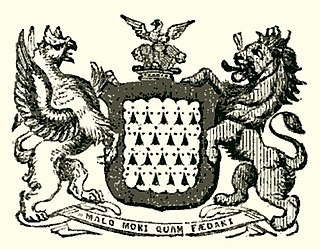Related Research Articles
Henry Deane was Archbishop of Canterbury from 1501 until his death.

Rowland FitzEustace, 1st Baron Portlester was an Irish peer, statesman and judge. He was one of the dominant political figures in late fifteenth-century Ireland, rivalled in influence probably only by his son-in-law Garret FitzGerald, the "Great" Earl of Kildare.

John Barnewall, 3rd Baron Trimleston, was an Irish nobleman, judge and politician. He was the eldest son of Christopher Barnewall, 2nd Baron Trimlestown and his wife Elizabeth Plunket, daughter of Sir Thomas Fitz-Christopher Plunket of Rathmore, Lord Chief Justice of the King's Bench in Ireland and his second wife Marian Cruise. He succeeded his father as 3rd Baron about 1513. His father, like most of the Anglo-Irish aristocracy, had supported the claim of the pretender Lambert Simnel to the English throne in 1487. After the failure of Simnel's rebellion, he received a royal pardon.
Nicholas St Lawrence, 4th Baron Howth was a leading Irish soldier and statesman of the early Tudor period, who held the office of Lord Chancellor of Ireland.
Walter Fitzsimon was a statesman and cleric in Ireland in the reign of Henry VII, who held the offices of Archbishop of Dublin and Lord Chancellor of Ireland.
Sir Thomas Cusack (also spelt Cusacke or Cusake) (1490–1571) was an Anglo-Irish judge and statesman of the sixteenth century, who held the offices of Master of the Rolls in Ireland, Lord Chancellor of Ireland, and Chancellor of the Exchequer of Ireland, and sat in the Irish House of Commons. He was one of the most trusted and dependable Crown servants of his time, although he led a somewhat turbulent private life.
Philip Bermingham (c.1420–1490) was an Irish judge who held the office of Lord Chief Justice of Ireland. He was regarded as "the most learned Irish lawyer of his time", but he had a somewhat turbulent political career and was twice accused of treason.
John Payne, Bishop of Meath, held that office from 1483 until his death in 1506; he was also Master of the Rolls in Ireland. He is best remembered for his part in the coronation of Lambert Simnel, the pretender to the Crown of England, in 1487.
Oliver FitzEustace was an Irish judge. His appointment as Chief Baron of the Irish Exchequer was a surprising one since according to the leading historian of the Irish judiciary he appears to have been unable to speak.
Sir Thomas Kent was an Irish judge who held office as Chief Baron of the Irish Exchequer.
John Estrete, or Strete was an Irish judge, author, law lecturer and statesman of the late fifteenth century. He held the offices of King's Serjeant, Deputy Chief Baron of the Irish Exchequer, and Master of the Coinage of Ireland. He was a member of the Privy Council of Ireland. He wrote at least one legal textbook, Natura Brevium.
Sir Henry Colley, or Cowley was an Irish soldier and landowner of the Elizabethan era. He is chiefly remembered today as an ancestor of the 1st Duke of Wellington.
The Brotherhood of Saint George was a short-lived military guild, which was founded in Dublin in 1474 for the defence of the English-held territory of the Pale. For a short time it was the only standing army maintained by the English Crown in Ireland. It was suppressed by King Henry VII in 1494, due to his suspicions about the Brotherhood's loyalty to his dynasty. It was not an order of knighthood, although some of its individual members were knights.

Thomas Talbot was a wealthy landowner and judge in fifteenth-century Ireland. He was the head of the prominent Talbot family of Malahide Castle. His descendants acquired the title Baron Talbot de Malahide, and he himself was recognised by the Crown as Lord of Malahide, although this was not a hereditary title. He was also Admiral of the Port of Malahide. By the time of his death he held lands in four counties and was one of the principal landowners in the Pale. After his death, there was a lawsuit between his widow Elizabeth and a Talbot relative, James, over possession of some of his properties.
Barnaby Barnewall was an Irish barrister and judge, and a founder member of the military guild, the Brotherhood of Saint George.
Sir Thomas Plunket (c.1440–1519) was a wealthy Irish landowner, lawyer and judge in fifteenth-century and early sixteenth-century Ireland. He held office as Chief Baron of the Irish Exchequer and Chief Justice of the Irish Common Pleas. After the change of the English royal dynasty in 1485, his loyalty to the new Tudor dynasty was deeply suspect, and he was involved in two attempts to put a pretender on the English throne. On each occasion he was disgraced, fined and removed from office; yet he had sufficient political influence to ensure his return to favour and high office.
Thomas Bowring (c.1440-1504) was an English-born lawyer and judge in fifteenth-century Ireland, who held office as Lord Chief Justice of Ireland.
Thomas Butler was an Irish judge, who held the office of Master of the Rolls in Ireland.
Patrick Burnell was an Irish judge and Crown official of the fifteenth century.

Walter de Cusack was an Anglo-Irish judge, magnate and military commander of the fourteenth century.